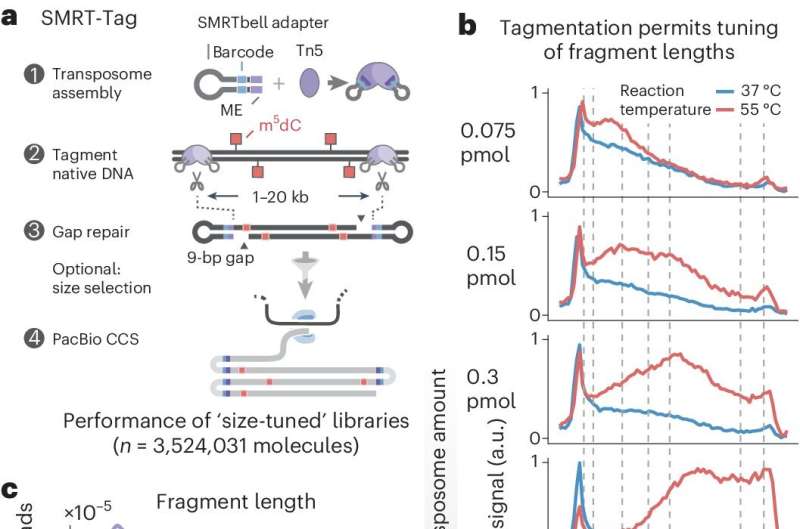This article has been reviewed according to Science X's editorial process and policies. Editors have highlighted the following attributes while ensuring the content's credibility:
fact-checked
peer-reviewed publication
trusted source
proofread
Scientists push single-molecule DNA sequencing to the next level

In recent years, technologies that allow scientists to study a person's DNA at single-molecule resolution have vastly expanded our knowledge of the human genome, the microbiome, and the genetic basis of disease. With such a detailed view of DNA, it's possible to see genetic variants and structural details that were simply undetectable with earlier sequencing technologies.
However, today's gold-standard methods for single-molecule analysis typically require at least 150,000 human cells—containing millions of individual DNA molecules. That means researchers can't apply these tools when just a few thousand cells are available, such as in many tumor biopsies, limiting the scientific and clinical potential of these technologies.
Now, researchers at Gladstone Institutes have developed two new tools for single-molecule analysis that slash the amount of DNA needed by 90 to 95%. Their work, published in the journal Nature Genetics, shows how these tools could allow scientists to address biological questions they were previously unable to answer.
"We've been working toward creating these methods for a very long time," says Vijay Ramani, Ph.D., assistant investigator at Gladstone and senior author of the study. "We're really excited to see what discoveries will now be possible."
'Tagging' DNA for a clearer view
The first of the new tools, known as "single-molecule real time sequencing by tagmentation," or SMRT-Tag, extends the established protocols for simultaneously mapping the sequence of bases in a long DNA fragment and locations of chemical structures called methyl groups, which lie along the length of the DNA. Methyl groups play a key role in gene expression, making them essential for understanding disease, so it's important to see how they're configured on DNA.
"When we have very little DNA to work with, we can't just make more copies of the DNA and apply our usual protocols," Ramani says. "Making copies would strip away these methylation patterns and introduce other errors."
Instead, his team adapted an approach called "tagmentation," which repurposes the bacterial protein Tn5 to simultaneously cut DNA molecules into more manageable fragments and tag them with chemical components necessary for further analysis.
Tagmentation is already used for sequencing short fragments of DNA when only small amounts of DNA are available—but only limited information can be gleaned from short fragments.
The challenge for Ramani's team was to get the biochemistry of tagmentation just right for breaking up small amounts of DNA into long chunks of about 3,000 to 5,000 base pairs. Their method "tags" the ends of each fragment with hairpin-shaped structures, creating long loops of DNA that can be read reliably by sequencer machinery.
"It was quite a heroic effort by the staff and students in my lab," Ramani says. "We had to test different versions of Tn5 and nearly 100 different conditions with different buffers, enzymes, and temperatures. When you're working with such small amounts of DNA, any issue that causes any DNA loss is that much more of a problem."
Actionable data from small samples
Once they optimized SMRT-Tag, the team demonstrated that it performs as well as established protocols but using far lower amounts of DNA—about the amount found in as few as 10,000 cells.
"Using gold-standard single-molecule sequencing machinery, no one has ever sequenced such a small amount of DNA to the coverage we've now achieved," Ramani says.
Next, his team combined SMRT-Tag with a method they previously developed called SAMOSA, short for "single-molecule adenine methylated oligonucleosome sequencing assay."
SAMOSA reveals additional methylation patterns that reflect chromatin accessibility—or, how easily gene expression machinery can access different stretches of DNA.
Now, with the new SAMOSA-Tag tool, the researchers were able to assess chromatin accessibility with much less DNA than previously needed. To demonstrate, they applied it to prostate cancer cells—some from a patient's initial tumor and some from a tumor that had spread to a different location in the body—that had been transplanted and grown in mice. The method revealed differences in chromatin accessibility that hint at possible key drivers of cancer metastasis.
"This is just one example of how our tools could be applied to clinically relevant samples in cancer and other diseases where DNA is in short supply," says Siva Kasinathan, MD, Ph.D., who co-led the study with Ramani. "We think there's some low-hanging fruit there that could unlock some new biology, which could be important for helping patients down the line."
Kasinathan, a clinical fellow at Lucille Packard Children's Hospital at Stanford University, is a visiting scientist at Gladstone and a longtime collaborator with Ramani.
Ramani's team is now optimizing SMRT-Tag and SAMOSA-Tag to work with even smaller amounts of DNA. They also continue to share and regularly update their protocols online, inviting feedback and collaboration from other researchers. "The community and people involved are really important in the story of this work," Ramani says.
In particular, he highlights his work with Kasinathan, who he met while they were in graduate school together at University of Washington. Together, they conceptualized the study. "It's been so meaningful to work with one of my closest friends to publish what we think will be very impactful work for human health."
More information: Arjun S. Nanda et al, Direct transposition of native DNA for sensitive multimodal single-molecule sequencing, Nature Genetics (2024). DOI: 10.1038/s41588-024-01748-0
Journal information: Nature Genetics
Provided by Gladstone Institutes





















